Case Based Questions Test: Electrostatic Potential & Capacitance - Grade 12 MCQ
15 Questions MCQ Test - Case Based Questions Test: Electrostatic Potential & Capacitance
Read the following text and answer the following questions on the basis of the same:
Supercapacitor: Super capacitor is a high capacity capacitor with a capacitance value much higher than normal capacitors but with lower voltage limits. Such capacitors bridges the gap between electrolytic capacitors and rechargeable batteries. In automobile, bus, train, crane, elevator such capacitors are used for regenerative braking, short term energy storage or burst-mode power delivery.
Super capacitors have many advantages over batteries: they are very low weight and generally don't contain harmful chemicals or toxic metal. They can be charged and discharged innumerable number of times without ever wearing out. The disadvantage is that super capacitors aren’t well-suited for long-term energy storage. The discharge rate of super capacitors is significantly higher than lithium-ion batteries; they can lose as much as 10-20% of their charge per day due to self discharge.
Capacity of supercapacitor is:
Read the following text and answer the following questions on the basis of the same: Supercapacitor: Super capacitor is a high capacity capacitor with a capacitance value much higher than normal capacitors but with lower voltage limits. Such capacitors bridges the gap between electrolytic capacitors and rechargeable batteries. In automobile, bus, train, crane, elevator such capacitors are used for regenerative braking, short term energy storage or burst-mode power delivery. Super capacitors have many advantages over batteries: they are very low weight and generally don't contain harmful chemicals or toxic metal. They can be charged and discharged innumerable number of times without ever wearing out. The disadvantage is that super capacitors aren’t well-suited for long-term energy storage. The discharge rate of super capacitors is significantly higher than lithium-ion batteries; they can lose as much as 10-20% of their charge per day due to self discharge.
Super capacitors can be charged and discharged:
Read the following text and answer the following questions on the basis of the same: Supercapacitor: Super capacitor is a high capacity capacitor with a capacitance value much higher than normal capacitors but with lower voltage limits. Such capacitors bridges the gap between electrolytic capacitors and rechargeable batteries. In automobile, bus, train, crane, elevator such capacitors are used for regenerative braking, short term energy storage or burst-mode power delivery. Super capacitors have many advantages over batteries: they are very low weight and generally don't contain harmful chemicals or toxic metal. They can be charged and discharged innumerable number of times without ever wearing out. The disadvantage is that super capacitors aren’t well-suited for long-term energy storage. The discharge rate of super capacitors is significantly higher than lithium-ion batteries; they can lose as much as 10-20% of their charge per day due to self discharge.
Super capacitors are used for
Read the following text and answer the following questions on the basis of the same:
Capacitor Colour Code: Capacitor values as written on small capacitors are sometimes misleading. Letters like p (pico) or n (nano) are used in place of the decimal point to identify its position and the value of the capacitor. For example, a capacitor labelled as n33 = 0.33nF, 8n2 = 8.2nF, 22n = 47nF and so on. Sometimes capacitors are marked with the capital letter K to signify a value of Kilo pico-Farads. As for example, a capacitor with the markings of 100K would be 1000 × 100 pF = 100 Kpf = 100 nF. Sometimes, a three letter code consists of the two value digits and a multiplier. For example, the digits 471 = 47 × 10 = 470 pF, 332 = 33 × 100 = 3300 pf. To reduce these confusions an International colour coding scheme was developed almost the same as that of resistance colour code.
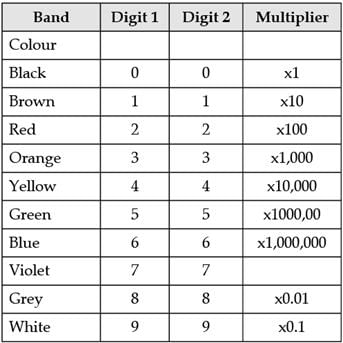
The value obtained from colour code is in pf.
What is the value of the capacitor if n27 is written on it?
Read the following text and answer the following questions on the basis of the same: Capacitor Colour Code: Capacitor values as written on small capacitors are sometimes misleading. Letters like p (pico) or n (nano) are used in place of the decimal point to identify its position and the value of the capacitor. For example, a capacitor labelled as n33 = 0.33nF, 8n2 = 8.2nF, 22n = 47nF and so on. Sometimes capacitors are marked with the capital letter K to signify a value of Kilo pico-Farads. As for example, a capacitor with the markings of 100K would be 1000 × 100 pF = 100 Kpf = 100 nF. Sometimes, a three letter code consists of the two value digits and a multiplier. For example, the digits 471 = 47 × 10 = 470 pF, 332 = 33 × 100 = 3300 pf. To reduce these confusions an International colour coding scheme was developed almost the same as that of resistance colour code.
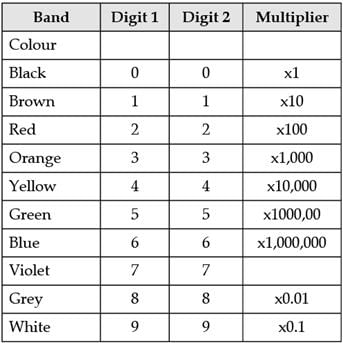
The value obtained from colour code is in pf.
68k is written on a capacitor. What is its value?
Read the following text and answer the following questions on the basis of the same: Capacitor Colour Code: Capacitor values as written on small capacitors are sometimes misleading. Letters like p (pico) or n (nano) are used in place of the decimal point to identify its position and the value of the capacitor. For example, a capacitor labelled as n33 = 0.33nF, 8n2 = 8.2nF, 22n = 47nF and so on. Sometimes capacitors are marked with the capital letter K to signify a value of Kilo pico-Farads. As for example, a capacitor with the markings of 100K would be 1000 × 100 pF = 100 Kpf = 100 nF. Sometimes, a three letter code consists of the two value digits and a multiplier. For example, the digits 471 = 47 × 10 = 470 pF, 332 = 33 × 100 = 3300 pf. To reduce these confusions an International colour coding scheme was developed almost the same as that of resistance colour code.
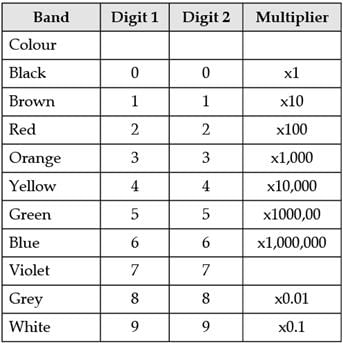
The value obtained from colour code is in pf.
What will be the colour code of a 27 nF capacitor?
Read the following text and answer the following questions on the basis of the same:
Power factor correction capacitor Power factor correction is a method to reduce the lagging power factor in inductive loads by fixing a high value capacitor across the phase and neutral line close to the load. When the Voltage and Current are in phase with each other in an AC circuit, the energy from the source is fully converted into another form to drive the load and in this case the power factor is in unity. When the power factor drops, the system becomes less efficient. In inductive loads, current “lags'' the voltage leading to “lagging power factor”. Power factor correction is the method to reduce the lagging power factor in inductive loads by fixing a high value capacitor across the phase and neutral close to the load. These capacitors have leading power factor so that it will neutralize the lagging power factor of the load. Power capacitors are huge non polarized metal film electrolytic type capacitors. Capacitors should be sufficiently rated to the load capacity. It should be connected to the lines, only when the loads are running and drawing current
What is meant by power factor correction?
Read the following text and answer the following questions on the basis of the same: Power factor correction capacitor Power factor correction is a method to reduce the lagging power factor in inductive loads by fixing a high value capacitor across the phase and neutral line close to the load. When the Voltage and Current are in phase with each other in an AC circuit, the energy from the source is fully converted into another form to drive the load and in this case the power factor is in unity. When the power factor drops, the system becomes less efficient. In inductive loads, current “lags'' the voltage leading to “lagging power factor”. Power factor correction is the method to reduce the lagging power factor in inductive loads by fixing a high value capacitor across the phase and neutral close to the load. These capacitors have leading power factor so that it will neutralize the lagging power factor of the load. Power capacitors are huge non polarized metal film electrolytic type capacitors. Capacitors should be sufficiently rated to the load capacity. It should be connected to the lines, only when the loads are running and drawing current
Power capacitors for power factor correction are
Read the following text and answer the following questions on the basis of the same: Power factor correction capacitor Power factor correction is a method to reduce the lagging power factor in inductive loads by fixing a high value capacitor across the phase and neutral line close to the load. When the Voltage and Current are in phase with each other in an AC circuit, the energy from the source is fully converted into another form to drive the load and in this case the power factor is in unity. When the power factor drops, the system becomes less efficient. In inductive loads, current “lags'' the voltage leading to “lagging power factor”. Power factor correction is the method to reduce the lagging power factor in inductive loads by fixing a high value capacitor across the phase and neutral close to the load. These capacitors have leading power factor so that it will neutralize the lagging power factor of the load. Power capacitors are huge non polarized metal film electrolytic type capacitors. Capacitors should be sufficiently rated to the load capacity. It should be connected to the lines, only when the loads are running and drawing current
Power factor corrector capacitors should be connected
Read the following text and answer the following questions on the basis of the same:
Supercapacitor: Super capacitor is a high capacity capacitor with a capacitance value much higher than normal capacitors but with lower voltage limits. Such capacitors bridges the gap between electrolytic capacitors and rechargeable batteries. In automobile, bus, train, crane, elevator such capacitors are used for regenerative braking, short term energy storage or burst-mode power delivery. Super capacitors have many advantages over batteries: they are very low weight and generally don't contain harmful chemicals or toxic metal. They can be charged and discharged innumerable number of times without ever wearing out. The disadvantage is that super capacitors aren’t well-suited for long-term energy storage. The discharge rate of super capacitors is significantly higher than lithium-ion batteries; they can lose as much as 10-20% of their charge per day due to self discharge.
Super capacitor makes a bridge between:
Read the following text and answer the following questions on the basis of the same: Supercapacitor: Super capacitor is a high capacity capacitor with a capacitance value much higher than normal capacitors but with lower voltage limits. Such capacitors bridges the gap between electrolytic capacitors and rechargeable batteries. In automobile, bus, train, crane, elevator such capacitors are used for regenerative braking, short term energy storage or burst-mode power delivery. Super capacitors have many advantages over batteries: they are very low weight and generally don't contain harmful chemicals or toxic metal. They can be charged and discharged innumerable number of times without ever wearing out. The disadvantage is that super capacitors aren’t well-suited for long-term energy storage. The discharge rate of super capacitors is significantly higher than lithium-ion batteries; they can lose as much as 10-20% of their charge per day due to self discharge.
Self-discharge rate of Supercapacitors:
Read the following text and answer the following questions on the basis of the same:
Capacitor Colour Code: Capacitor values as written on small capacitors are sometimes misleading. Letters like p (pico) or n (nano) are used in place of the decimal point to identify its position and the value of the capacitor. For example, a capacitor labelled as n33 = 0.33nF, 8n2 = 8.2nF, 22n = 47nF and so on. Sometimes capacitors are marked with the capital letter K to signify a value of Kilo pico-Farads. As for example, a capacitor with the markings of 100K would be 1000 × 100 pF = 100 Kpf = 100 nF. Sometimes, a three letter code consists of the two value digits and a multiplier. For example, the digits 471 = 47 × 10 = 470 pF, 332 = 33 × 100 = 3300 pf. To reduce these confusions an International colour coding scheme was developed almost the same as that of resistance colour code.
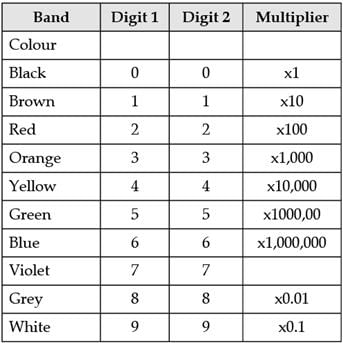
The value obtained from colour code is in pf.
Two capacitors marked as 221 and 220 respectively are joined in parallel. What is the total capacitance value?
Read the following text and answer the following questions on the basis of the same: Capacitor Colour Code: Capacitor values as written on small capacitors are sometimes misleading. Letters like p (pico) or n (nano) are used in place of the decimal point to identify its position and the value of the capacitor. For example, a capacitor labelled as n33 = 0.33nF, 8n2 = 8.2nF, 22n = 47nF and so on. Sometimes capacitors are marked with the capital letter K to signify a value of Kilo pico-Farads. As for example, a capacitor with the markings of 100K would be 1000 × 100 pF = 100 Kpf = 100 nF. Sometimes, a three letter code consists of the two value digits and a multiplier. For example, the digits 471 = 47 × 10 = 470 pF, 332 = 33 × 100 = 3300 pf. To reduce these confusions an International colour coding scheme was developed almost the same as that of resistance colour code.
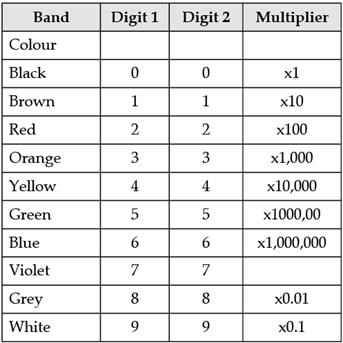
What is the value of the capacitor bearing a colour code: brown, green, brown?
Read the following text and answer the following questions on the basis of the same:
Power factor correction capacitor Power factor correction is a method to reduce the lagging power factor in inductive loads by fixing a high value capacitor across the phase and neutral line close to the load. When the Voltage and Current are in phase with each other in an AC circuit, the energy from the source is fully converted into another form to drive the load and in this case the power factor is in unity. When the power factor drops, the system becomes less efficient. In inductive loads, current “lags'' the voltage leading to “lagging power factor”. Power factor correction is the method to reduce the lagging power factor in inductive loads by fixing a high value capacitor across the phase and neutral close to the load. These capacitors have a leading power factor so that it will neutralize the lagging power factor of the load. Power capacitors are huge non polarized metal film electrolytic type capacitors. Capacitors should be sufficiently rated to the load capacity. It should be connected to the lines, only when the loads are running and drawing current
When the energy from source is fully converted into another form, the power factor is
Read the following text and answer the following questions on the basis of the same: Power factor correction capacitor Power factor correction is a method to reduce the lagging power factor in inductive loads by fixing a high value capacitor across the phase and neutral line close to the load. When the Voltage and Current are in phase with each other in an AC circuit, the energy from the source is fully converted into another form to drive the load and in this case the power factor is in unity. When the power factor drops, the system becomes less efficient. In inductive loads, current “lags'' the voltage leading to “lagging power factor”. Power factor correction is the method to reduce the lagging power factor in inductive loads by fixing a high value capacitor across the phase and neutral close to the load. These capacitors have a leading power factor so that it will neutralize the lagging power factor of the load. Power capacitors are huge non polarized metal film electrolytic type capacitors. Capacitors should be sufficiently rated to the load capacity. It should be connected to the lines, only when the loads are running and drawing current
Power capacitors for power factor correction have



















